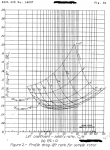Hi Paolo,
I had promised a few figures concerning jump take-off for the weekend and here they are
(at the bottom of this text). So what did I do? A very comprehensive investigation into
that question was carried out by J.B Wheatley and C. Bioletti in naca tn 582 titled
"Analysis and Model Tests of Autogiro Jump Take-Off" in 1936. You can find it here:
http://ntrs.nasa.gov/archive/nasa/casi.ntrs.nasa.gov/19930081354_1993081354.pdf
Friday night I started to implement the formulae of that report in a program for octave.
The code for octave is usually compatible with matlab. The program calculates the time
history of a jump take-off for a given initial rotor speed. In the report curves of a torque
coefficient were given for a rotor solidity of sigma= 0.1 and 0.05. I digitized these
curves and made a least square fit on them. The cq values are then interpolated between
collective pitch values theta. Currently no interpolation is performed for intermediate sigma
values.
The lift was at first calculated using a constant lift curve solpe of 6.3, a value that
is quite a bit higher than the 5.5 - 5.7 usually emplyod, yet due to the ground effect
in a jump take-off the lift will be higher than in free air. The values calculated by
the program agreed quite well with the tests for collective pitch values theta of about
10 degrees. At 16° the approximation broke down. (see below: poor agreement...) After
some tests I concluded that the lift curve solpe is grossly in error a this angle. I
had implemented a routine to calculte lift coefficient values based on data generated
with the program X-foil before. The data are for the naca 0012 profile. After incorpo-
rating this routine in the program values for larger theta are much better now.
Two things in the examples below are quite striking:
a) if rotor solidity sigma is reduced to one half (0.05 instead of 0.1) the jump height
drops from 10.5 to 0.4 feet for a certain combination of parameters. Note that
kinetic energy is not affected by this since blade inertia is calculated from mass
only.
b) a tip weight of about 10% of the blade weight increases jump height by about 35%
(from 7.8 to 10.5 feet)
The last column below (h582) gives the hight that was measured in the report. Below
that is a complete time history for an initial rotor rpm of 648 1/min. There will definitely
be errors in the values returned by the program but I think that it is more than sufficient
to explore the trend for different designs.
Cheers for now,
Juergen
sigma iBlade mBlade mTip dskLd fdgF fdgFH rpm jrpm thtaN hMax tMax h582
- [slug-ft^2] [lb] [lb] [lb/ft^2] - - [1/min] [1/min] Deg [°] [ft]
[ft]
0.10080 3.11 6.00 0.00 1.06 1.0 1.0 220.00 700.00 10.00 22.8 3.8 19.5
0.10080 3.11 6.00 0.00 1.06 1.0 1.0 220.00 700.00 8.00 5.0 2.2
0.10080 3.11 6.00 0.00 1.06 1.0 1.0 220.00 650.00 10.00 12.4 3.1 12.0
0.10080 3.11 6.00 0.00 1.06 1.0 1.0 220.00 650.00 8.00 1.1 1.3
0.10080 3.11 6.00 0.00 1.06 1.0 1.0 220.00 725.00 8.00 7.8 2.5 9.4
0.10080 4.04 6.00 0.60 1.06 1.0 1.0 220.00 725.00 8.00 10.5 3.1 na
sigma reduced to one half
0.05040 4.04 6.00 0.60 1.06 1.0 1.0 220.00 725.00 8.00 0.4 1.2 na
0.10080 3.11 6.00 0.00 0.76 1.0 1.0 220.00 648.00 8.00 13.4 3.4 20.5
0.10080 3.11 6.00 0.00 1.65 1.0 1.0 220.00 700.00 8.00 0.0 0.0
0.10080 3.11 6.00 0.00 1.65 1.0 1.0 220.00 700.00 12.00 8.5 2.6 8.2
poor agreement with test data due to constant lift curve slope.
0.10080 3.11 6.00 0.00 1.65 1.0 1.0 220.00 648.00 16.00 32.5 4.3
lift curve slope reduced
0.10080 3.11 6.00 0.00 1.65 1.0 1.0 220.00 648.00 16.00 2.6 1.7
lift curve slope now calculated from naca 0012 data generated with X foil
0.10080 3.11 6.00 0.00 1.06 1.0 1.0 220.00 648.00 10.00 16.9 3.5 19.5
sigma 0.10080 iBlade 3.11 dskLd 1.06 fdgF 1.0 fdgFH 1.0
rpm 220.00 jrpm 648.00 thtaN 10.00
Output File : JumpTakeOff_i.dat
time rotor rpm height h hDot h2Dot
1/[min] [ft] [ft/s] [ft/s^2]
0.00 648.00 0.00 0.00 20.26
0.20 612.50 0.35 3.31 13.26
0.40 580.75 1.25 5.44 8.30
0.60 552.46 2.47 6.73 4.76
0.80 527.03 3.90 7.41 2.24
1.00 503.93 5.41 7.67 0.43
1.20 482.71 6.94 7.62 -0.87
1.40 463.06 8.44 7.34 -1.81
1.60 444.77 9.87 6.91 -2.47
1.80 427.68 11.20 6.37 -2.95
2.00 411.69 12.41 5.74 -3.29
2.20 396.74 13.49 5.06 -3.52
2.40 382.78 14.43 4.34 -3.68
2.60 369.78 15.22 3.59 -3.79
2.80 357.73 15.86 2.82 -3.86
3.00 346.61 16.35 2.05 -3.89
3.20 336.43 16.68 1.27 -3.91
3.40 327.19 16.86 0.49 -3.91
3.60 318.88 16.88 -0.29 -3.89
3.80 311.51 16.74 -1.07 -3.87
4.00 305.09 16.45 -1.84 -3.84
4.20 299.60 16.00 -2.61 -3.81
#### End JumpTakeOff282 ####
